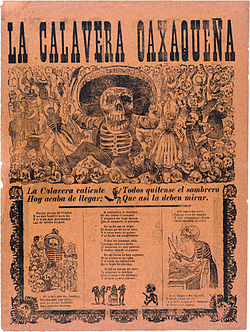José Guadalupe Posada
José Guadalupe Posada | |
|---|---|
Lithographer | |
| Known for | Calaveras |
| Spouse |
María de Jesús Vela (m. 1875) |

José Guadalupe Posada Aguilar (2 February 1852 – 20 January 1913) was a Mexican political printmaker who used
Early life and education

Posada was born in
In 1871, before he was out of his teens, his career began with a job as the
From 1875 to 1888, Posada continued to collaborate with several newspapers in León, including La Gacetilla, el Pueblo Caótico and La education. He survived the great flood of León on 18 June 1888, of which he published several lithographs representing the tragedy in which more than two hundred and fifty corpses were found and more than 1,400 people were reported missing.[7]
At the end of 1888, he moved to Mexico City, where he learned the craft and technique of engraving in lead and zinc. He collaborated with the newspaper La Patria Ilustrada and the Revisita de Mexico until the early months of 1890.[8]
Career as artist



He began to work with Antonio Vanegas Arroyo, until he was able to establish his own lithographic workshop. From then on Posada undertook work that earned him popular acceptance and admiration for his sense of humor and propensity concerning the quality of his work. In his broad and varied work, Posada portrayed beliefs, the daily lifestyles of popular groups, the abuses of government, and the exploitation of the common people. He illustrated the famous skulls, along with other illustrations that became popular as they were distributed to various newspapers and periodicals.[9]
In 1883, following his success, he was hired as a teacher of lithography at the local Preparatory School. The shop flourished until 1888 when a disastrous flood hit the city. He subsequently moved to Mexico City. His first regular employment in the capital was with La Patria Ilustrada, whose editor was
From the outbreak of the Mexican Revolution in 1910 until his death in 1913, Posada worked tirelessly in the press. The works he completed in his press during this time allowed him to develop his artistic prowess as a draftsman, engraver and lithographer. At the time he continued to make satirical illustrations and cartoons featured in the magazine, El Jicote. He played a crucial role in the government during the presidency of Francisco I Madero and during the campaign of Emiliano Zapata.[10]
Notable works
Posada's best known works are his calaveras. His most famous and influential work is the La Calavera Catrina, which was first published posthumously in a 1913 broadside. Catrina was probably intended as a satirical portrait of Mexican elites who were imitating European fashions, but the text, which was not written by the artist, satirized working class vendors of chickpeas. Posada's Catrina image appeared in several other broadsides. It was elaborated into a full figure by the muralist Diego Rivera. Catrina is now the most widespread image associated with the Day of the Dead.[11]
Later life and death
Largely forgotten by the end of his life, José Guadalupe Posada died in 1913 of gastroenteritis.[12] Three of his neighbors certified his death, although only one of them knew his full name.[13] He reportedly died penniless and was ultimately buried in an unmarked pauper's grave.[14][15]
Legacy


Academics have estimated that during his long career, Posada produced 20,000 plus images for broadsheets, pamphlets and chapbooks.[13] Posada was studied by key figures of Mexican muralism, including Jean Charlot, Diego Rivera, and José Clemente Orozco, who created national art.[17] Rivera advanced the false belief that Posada was a proto-revolutionary artist.[11]
Though Posada has usually been characterized as someone who utilized traditional craft techniques, he likely used photomechanical processes and deliberately made distressed-looking images in order to appeal to his downscale clientele.[18] Frida Kahlo spoke "almost reverentially" of Posada and posted some of his prints in her hotel room in New York City in 1933. [19]
In the 1920s, the French born Mexican artist Jean Charlot was the first to popularize Posada's broadsides as art. In 1929 Anita Brenner's book Idols Behind Altars used Posada's illustrations. Brenner called Posada a prophet and linked him to the Mexica, peasants and workers.[17] The US author Frances Toor promoted Posada as folklore with her 1930 book Posada: Grabador Mexicano, the first monograph on Posada.[20] Rivera commented on 406 prints by Posada in the foreword for the book.[21]
When

See also
References
- ^ "Mexican artist José Guadalupe Posada". Posada Art Foundation. Retrieved 31 January 2022.
- ISBN 978-0-19-936643-9, retrieved 3 November 2024
- ^ Barajas (2009), p. 37
- ^ Barajas (2009), p. 38
- ^ History of Mexico – Mexico's Daumier: Josejhg Guadalupe Posada, Jim Tuck, Mexico Connect
- ^ Barajas (2009), pp. 49–50
- ^ Barajas (2009), pp. 52–57, 64–70
- ^ Barajas (2009), pp. 70–76
- ^ Barajas (2009), pp. 105, 110–113
- ^ "Fondo de Cultura Económica". fondodeculturaeconomica.
- ^ a b c Cordova, Ruben C. (2 November 2019). "José Guadalupe Posada and Diego Rivera Fashion Catrina: From Sellout To National Icon (and Back Again?)". Glasstire. Retrieved 13 March 2023.
- JSTOR 1504066.
- ^ ISBN 978-0-8165-2647-5.
- ^ "The Calaveras of José Guadalupe Posada". The Public Domain Review. Retrieved 21 January 2023.
- ^ "About the Artist [José Guadalupe Posada: Symbols, Skeletons, and Satire]". The Clark. Clark Art Institute. Retrieved 21 January 2023.
- ISBN 978-1-4051-7870-9.
- ^ ISBN 978-1-61069-044-7.
- ^ Cordova, Ruben C. (2019). The Day of the Dead in Art (PDF). San Antonio: The City of San Antonio, Department of Arts & Culture. pp. 11–12.
- ISBN 0-679-74631-5.
- OCLC 70876918.
- ISBN 978-1-4051-7870-9.
- ISBN 978-0-292-71250-8.
- Bibliography
- Barajas, Rafael (2009). Myth and mitote: the political caricature of Jose Guadalupe Posada and Manuel Alfonso Manila. Fondo de Cultura Economica. ISBN 9786071600752.
External links
- José Guadalupe Posada prints, 1880–1943, Getty Research Institute, Research Library, Accession no. 960060.
- Posada Art Foundation












